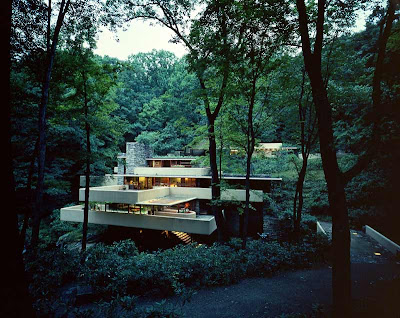 The only good thing about your family having a house in the middle of nowhere is that it's only an hour away from one of the most famous houses in America, Frank Lloyd Wright's Fallingwater, also in the middle of nowhere. I first visited the site over 20 years ago so I thought it was about time for a second look, which is what I did this past weekend. Although, wearing Christian Louboutin flats on the tour probably wasn't the brightest idea I've ever had so if you plan to visit, I suggest taking along a pair of sneakers since a lot of the tour is outside.
The only good thing about your family having a house in the middle of nowhere is that it's only an hour away from one of the most famous houses in America, Frank Lloyd Wright's Fallingwater, also in the middle of nowhere. I first visited the site over 20 years ago so I thought it was about time for a second look, which is what I did this past weekend. Although, wearing Christian Louboutin flats on the tour probably wasn't the brightest idea I've ever had so if you plan to visit, I suggest taking along a pair of sneakers since a lot of the tour is outside."Fallingwater is recognized as one of Wright's most acclaimed works, and in a 1991 poll of members of the American Institute of Architects, it was voted "the best all-time work of American architecture." It is a supreme example of Frank Lloyd Wright's concept of organic architecture, which promotes harmony between man and nature through design so well integrated with its site that buildings, furnishings, and surroundings become part of a unified, interrelated composition."
Fallingwater was designed in 1935 for the Edgar J. Kaufmann family of Pittsburgh, who owned the famous Kaufmann's department store and vacationed in the Mill Run area of Pennsylvania. The family asked Wright to build a home near the Bear Run waterfall that they loved. What they didn't expect was for Wright to design the house over the waterfall but they agreed to the plan and it was built almost exactly as it was planned. The interesting part of the story was that it was the Kaufmann's son, Edgar Kaufmann, jr. who brought about the collaboration with Wright, who's career was in a bit of a slump at the time.
"After having read Frank Lloyd Wright’s An Autobiography (1932) on the advice of a friend, he was inspired to join the Taliesin Fellowship, which Wright and his wife, Olgivanna, had recently founded as an institute for artistic growth. In September, Edgar jr. traveled to Wisconsin for an interview with Wright, and a month later he was officially inscribed as a member of the fellowship. His stay at Taliesin only lasted six months, however, and he returned to Pittsburgh in 1935 to take his long deferred place in the family store. Over the next seven years, he played a pivotal role in integrating the family’s interest in progressive design, in Wright’s work, and business." He later went on to work for the Museum of Modern Art in New York and the family's story is so interesting that it's definitely worth reading online.
 One of the things that almost all visitors notice upon arrival to Fallingwater is how modern and contemporary it looks for a design that was finished in 1939. It is also the only great Wright house open to the public with its setting, original furnishings, and art work intact. Almost all of the original Wright-designed furnishings are still in place. Fine art, textiles, objets d'art, books, and furnishings collected by the Kaufmann family from the 1930's through the 1960's are on view, and represent the eclectic tastes of a sophisticated, world-traveled family. Included in the collections are works by Audubon, Tiffany, Diego Rivera, Picasso, Jacques Lipchitz, Richmond Barthe, and woodblock prints by Japanese artists Hiroshige and Hokusai - gifts from Frank Lloyd Wright to the Kaufmanns.
One of the things that almost all visitors notice upon arrival to Fallingwater is how modern and contemporary it looks for a design that was finished in 1939. It is also the only great Wright house open to the public with its setting, original furnishings, and art work intact. Almost all of the original Wright-designed furnishings are still in place. Fine art, textiles, objets d'art, books, and furnishings collected by the Kaufmann family from the 1930's through the 1960's are on view, and represent the eclectic tastes of a sophisticated, world-traveled family. Included in the collections are works by Audubon, Tiffany, Diego Rivera, Picasso, Jacques Lipchitz, Richmond Barthe, and woodblock prints by Japanese artists Hiroshige and Hokusai - gifts from Frank Lloyd Wright to the Kaufmanns.Even though it is in the middle of nowhere, it is definitely worth making a pilgrimage to Fallingwater to see one of the finest examples of architecture ever created. Just make sure you wear proper footwear!


0 comments:
Post a Comment